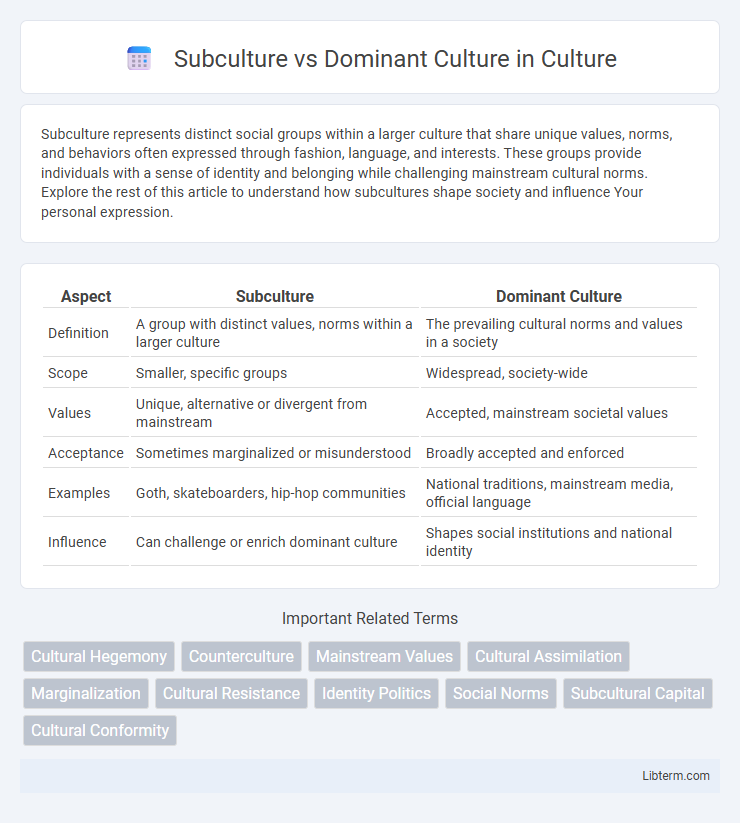Subculture represents distinct social groups within a larger culture that share unique values, norms, and behaviors often expressed through fashion, language, and interests. These groups provide individuals with a sense of identity and belonging while challenging mainstream cultural norms. Explore the rest of this article to understand how subcultures shape society and influence Your personal expression.
Table of Comparison
| Aspect | Subculture | Dominant Culture |
|---|---|---|
| Definition | A group with distinct values, norms within a larger culture | The prevailing cultural norms and values in a society |
| Scope | Smaller, specific groups | Widespread, society-wide |
| Values | Unique, alternative or divergent from mainstream | Accepted, mainstream societal values |
| Acceptance | Sometimes marginalized or misunderstood | Broadly accepted and enforced |
| Examples | Goth, skateboarders, hip-hop communities | National traditions, mainstream media, official language |
| Influence | Can challenge or enrich dominant culture | Shapes social institutions and national identity |
Defining Subculture and Dominant Culture
Dominant culture refers to the prevailing set of values, beliefs, and norms that shape the behavior and social practices of the majority within a society. Subculture represents a smaller group within the larger cultural framework, characterized by distinct patterns of behavior, language, and values that differentiate it from the dominant culture. These subcultural groups often form around shared interests, identities, or lifestyles while maintaining some level of interaction with or resistance to the dominant cultural norms.
Origins and Evolution of Subcultures
Subcultures originate from shared interests, values, or experiences that distinguish a group from the dominant culture, often emerging as a response to social, economic, or political conditions. The evolution of subcultures involves the development of unique styles, language, and behaviors that provide members with a sense of identity and belonging while challenging mainstream norms. Over time, some subcultures influence or integrate into the dominant culture, contributing to its diversity and dynamic nature.
Characteristics of Dominant Culture
Dominant culture exhibits widespread acceptance and influence, often shaping societal norms, values, and institutions that guide collective behavior. It maintains power by reinforcing ideologies through media, education, and governance, promoting conformity and social cohesion. Characteristics include a shared language, common customs, and dominant beliefs that marginalize alternative subcultures.
Key Differences Between Subculture and Dominant Culture
Subcultures exhibit distinct beliefs, values, and behaviors that differ from the dominant culture, often emerging within specific social groups or communities. While dominant culture represents the prevailing norms, customs, and ideologies widely accepted and practiced by the majority, subcultures challenge or modify these mainstream cultural elements. The key difference lies in the level of social acceptance and influence, with dominant culture shaping societal standards and subcultures providing alternative perspectives and identities.
How Subcultures Challenge Mainstream Norms
Subcultures challenge mainstream norms by establishing alternative values, styles, and behaviors that resist dominant cultural expectations. Through distinct language, fashion, and social rituals, subcultures create spaces for marginalized identities and dissenting perspectives. This active opposition reshapes societal definitions of identity and belonging, often prompting shifts in mainstream cultural practices.
Integration and Conflict: Subcultures vs Dominant Culture
Subcultures often develop unique values, norms, and practices that distinguish them from the dominant culture while still interacting and integrating within the broader societal framework. Integration occurs when subcultures adopt certain elements of the dominant culture, facilitating coexistence and mutual influence without losing their distinct identity. Conflict arises when subcultural values challenge dominant cultural norms, leading to social tension, resistance, or efforts to marginalize the subculture.
Role of Media in Shaping Cultural Perceptions
Media plays a crucial role in shaping perceptions of subcultures and dominant culture by selectively highlighting norms, values, and behaviors that reinforce societal hierarchies. Dominant culture often benefits from disproportionate representation, which legitimizes mainstream ideologies while marginalizing subcultural identities. Through framing, agenda-setting, and stereotyping, media influences public understanding and acceptance of diverse cultural expressions.
Influence of Subcultures on Societal Change
Subcultures introduce alternative values, beliefs, and practices that challenge the dominant culture, often serving as catalysts for societal transformation. By promoting new ideas in areas such as fashion, language, music, and social norms, subcultures can gradually shift mainstream perspectives and stimulate cultural evolution. Historical examples include the counterculture movements of the 1960s that influenced civil rights, environmentalism, and gender roles, demonstrating subcultures' power to reshape dominant cultural frameworks.
Examples of Subcultures Throughout History
Punk rock emerged in the 1970s as a rebellious subculture characterized by distinctive music, fashion, and anti-establishment values, challenging mainstream norms. The Beat Generation of the 1950s fostered a literary subculture emphasizing non-conformity, spiritual exploration, and critique of materialism within dominant post-war American culture. More recently, the goth subculture, with its dark aesthetics and alternative music, has persisted as a niche community that contrasts sharply with prevailing societal trends.
The Future of Subculture and Dominant Culture Dynamics
The future of subculture and dominant culture dynamics will be shaped by increasing technological advancements and social connectivity, allowing subcultures to emerge rapidly and influence mainstream norms. Digital platforms enable niche communities to gain visibility and challenge dominant cultural narratives, fostering greater diversity and hybrid identities. As globalization intensifies, the interplay between subculture and dominant culture will drive continuous cultural evolution and adaptation.
Subculture Infographic

 libterm.com
libterm.com